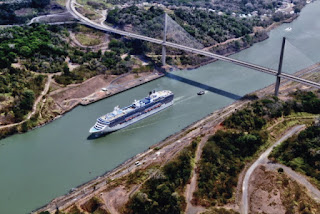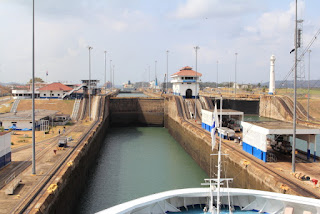The idea of connecting the Atlantic and Pacific Oceans for a shorter trade route between East and West was first conceived by Spanish explorers when they arrived on the Panama isthmus and realized how close the oceans were together at that point. But, it was not until 1880 when the French decided that they had the expertise to built the Canal and construction actually started. Unfortunately, the French ran into financial problems and, when considering the high rate of deaths due to diseases, the project was abandoned.
In 1903 President Teddy Roosevelt worked out an agreement with the Panama government that the US would finish the canal if the Panama government would give the US canal operating rights into perpetuity. The Panama government agreed to the terms because the design included ports on both ends of the Canal and the Canal would create a large number of jobs for their country. (Unfortunately, when President Jimmy Carter was in office, he gave the Canal to Panama as a goodwill gesture.)
On August 15, 1914, the canal was finished and the SS Ancon was the first ship to make the full transit from the Atlantic Ocean to the Pacific Ocean. The American Society of Civil Engineers has named the Panama Canal as one of the Seven Wonders of the Modern World.
Cruise ships make their reservation to go through the Canal 18 months in advance, at a cost of about $265,000, so they get priority passage.
Once our ship entered the Canal Zone and passed the breakwater, we were met by a Pilot boat that transferred four Pilots to our ship. At the same time, the ship's film grew went ashore so that they could film our passage through the Canal from the ground and the air (they rented a helicopter).
The Pilots safely guided our large passenger ship into the Gatun Locks (three separate locks) where they attached cables from the ship to large electric "mules" that run on tracks adjacent to the canal. The ship actually propels itself through the locks; the "mules" (about 8 total) are just used to keep the ship in the center of the canal so that the ship does not scrape the concrete sides of the locks.
There are two sets of parallel locks and it was interesting to stand on the ship's balcony and watch other ships move up and down that were going through the locks at the same time.
After passage through the Gatun Locks, the ship exited into Gatun Lake. (Gatun Lake is about 85 feet higher than sea level.)
 |
| Picture by Ship Photographer |
 |
| Picture by Ship Photographer |
 |
| Picture by Ship Photographer |
After passing the community of Gamboa, the waters from Alhajuela Lake flow into the canal and the water becomes much cleaner. Also, just past the river junction is the estate of Manuel Noriega.
Continuing along the Canal the ship came to the Culebra Cut, which was the most difficult part of the canal excavation because the Cut crosses the Continental Divide at this point. Once past the Cut, the Pan-American Highway Centennial Bridge crosses the Canal. (The Centennial Bridge opened in 2004 and the Pan-American Highway was realigned to relieve traffic congestion on the Bridge of the Americas.)
 |
| Picture by Ship Photographer |
 |
| Picture by Ship Photographer |
Estimated travel time through the canal was listed on our itinerary as 11 hours, but it required about 12 hours for out trip. After being on the observation deck for 12 hours, I was red as a lobster and suffered from wind and sun burn! (Next time remember the sun screen!)














































No comments:
Post a Comment